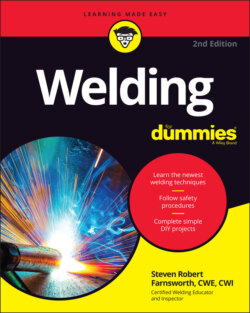Читать книгу Welding For Dummies - Steven Robert Farnsworth - Страница 52
Choosing eye protection
ОглавлениеTo protect your eyes from flying debris (usually metal), which you encounter plenty of if you weld regularly, make sure you wear safety glasses in your shop at all times. Make a habit of putting them on as soon as you walk in the door — that way, you’re always protected.
To fully protect your eyes from the damaging effects of ultraviolet welding rays, you need a welding helmet. These helmets protect your eyes (and the rest of your face) from damaging rays, and they include special lenses that allow you to see your work clearly without suffering eye injuries, which I discuss in “Shielding yourself from burns” later in the chapter. (Check out Figure 3-1 for a look at what a welder with a welding helmet looks like.)
You need to get a helmet appropriate for your particular welding work. New welders often buy helmets that don’t cover all their needs, or purchase ones that are far too heavy duty (and therefore expensive) for the projects they want to do. The following list explains the features of welding helmets that can help you figure out which helmet is right for you:
Shade number: The lenses in welding helmets are rated according to shade number. Shade numbers for welding range from #8 to #14. The higher the shade number, the higher the amperage (the amount of electrical energy flowing through a circuit) you can use when welding without damaging your eyes. Most welding operations are carried out at shade #10, but if you get above 140 amps you must get a darker lens with a shade in the #12 to #14 range.
Auto-darkening or passive lens: Many welding helmets now offer an auto-darkening lens that automatically increases the shade number to account for more-intense welding rays. The alternative is a passive lens, which is the older style of helmet that has a fixed shade number. Auto-darkening helmets are nice because you can see through the lens when you don’t have a live welding arc, so you don’t have to constantly take your helmet off and put it back on when you’re working on a project. However, auto-darkening helmets are much more expensive. Passive lens helmets are cheaper, but you’ll likely have to remove them and put them back on over and over while you’re welding.
Comfort: Make sure you get a helmet with an adjustable headband that feels comfortable on your head and neck. The helmet should stay in place and shouldn’t pinch your head.
Welding helmets take a lot of abuse, but you don’t have to replace your helmet if it gets nasty or dinged up. You can always repair or replace parts of the helmet (lenses, shields, and headbands for example) instead of emptying your wallet on a new one.
Sunglasses don’t protect the eyes from welding rays. Don’t even think about using them as eye protection.
Make sure you do whatever you can to protect the eyes of others who may be near your welding projects. Ultraviolet welding rays are so powerful that they can penetrate through closed eyelids. If you have bystanders, make sure you say “Cover!” loudly before you strike an arc and get started welding. (You need to let your audience know beforehand what to expect when you say “Cover!”, of course.)
